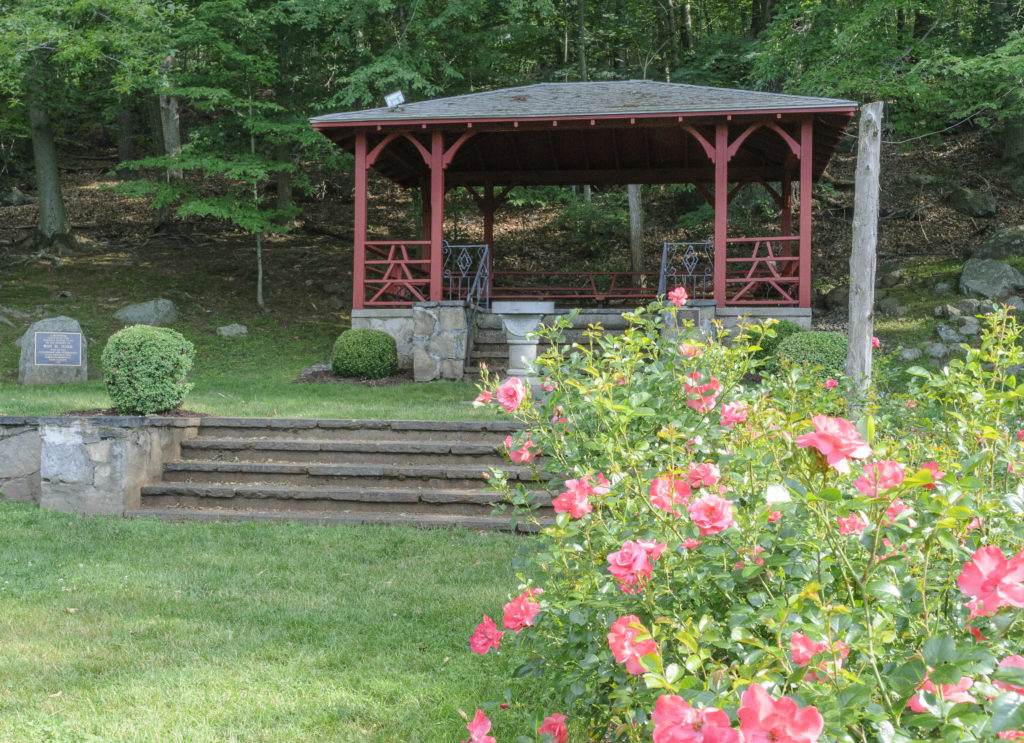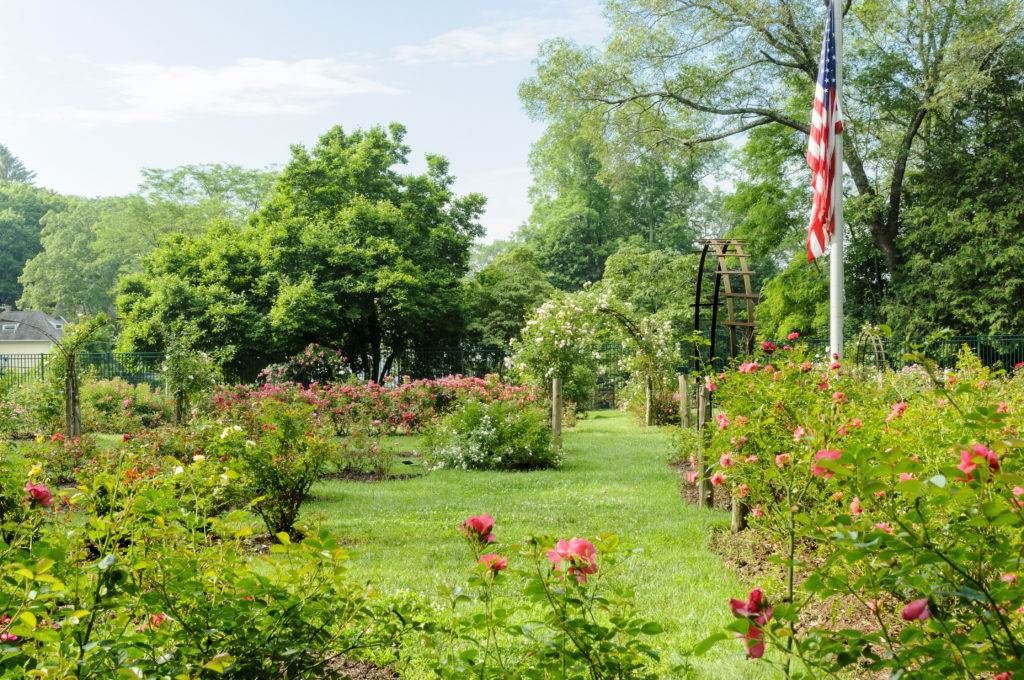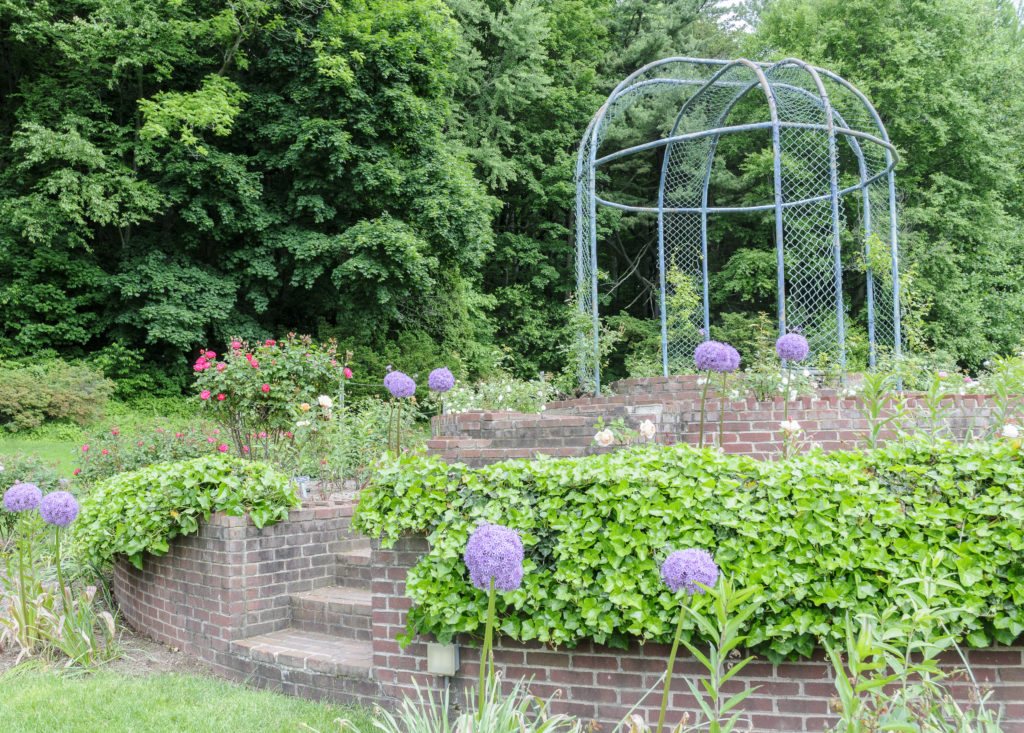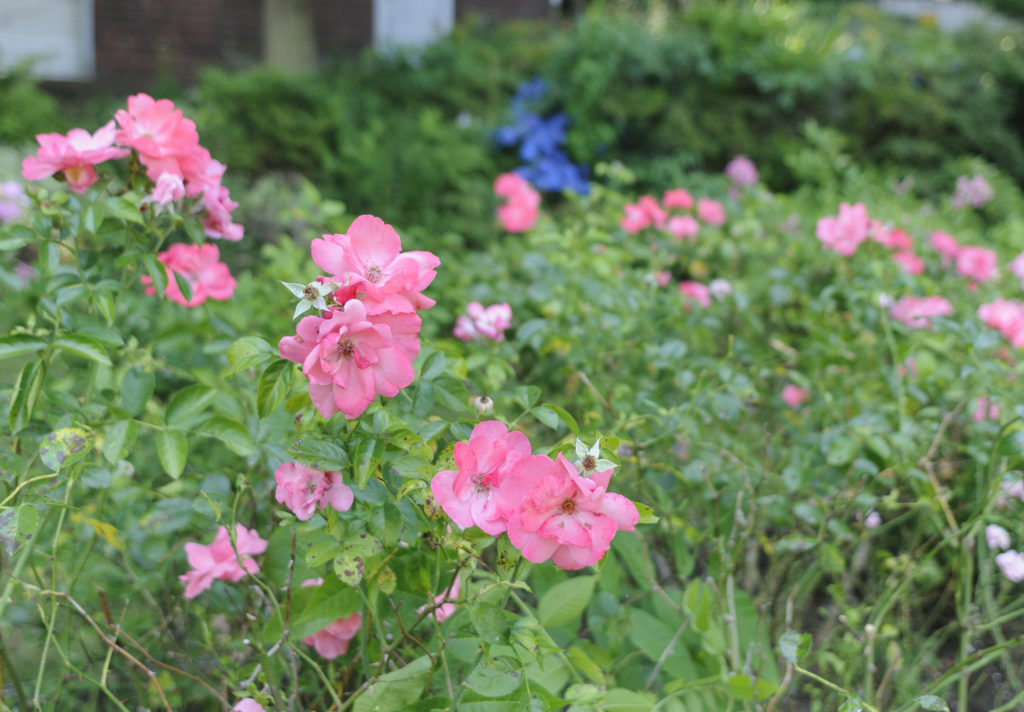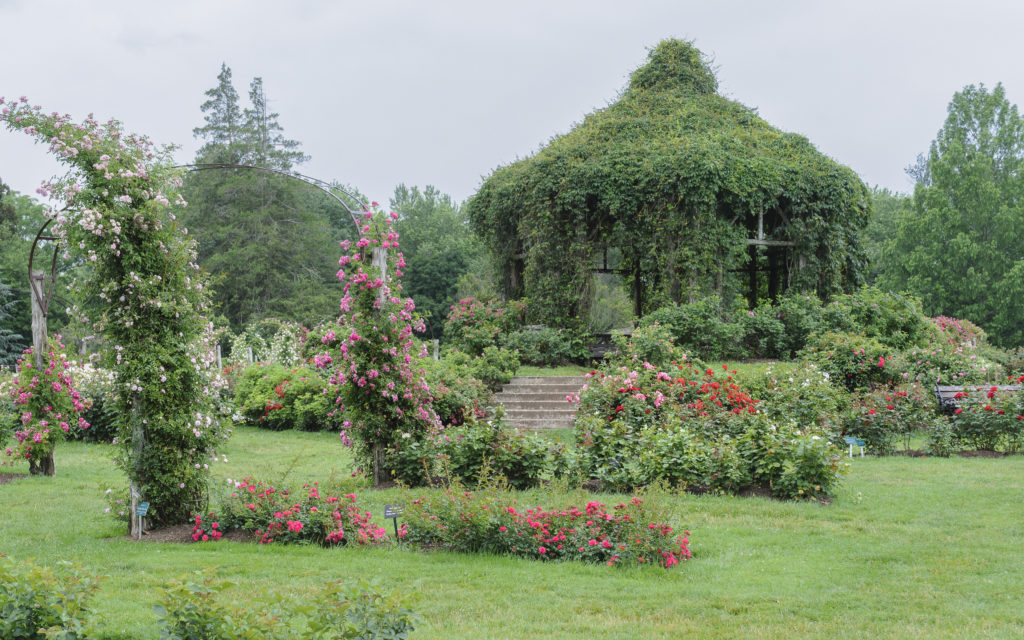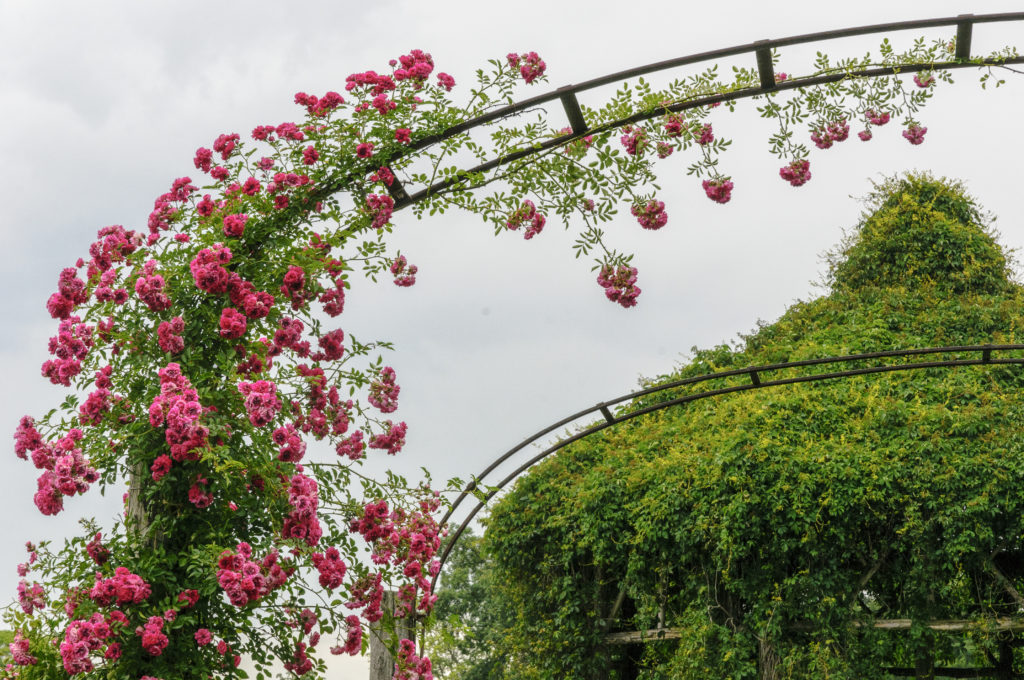SUBSCRIBE/BUY THE ISSUE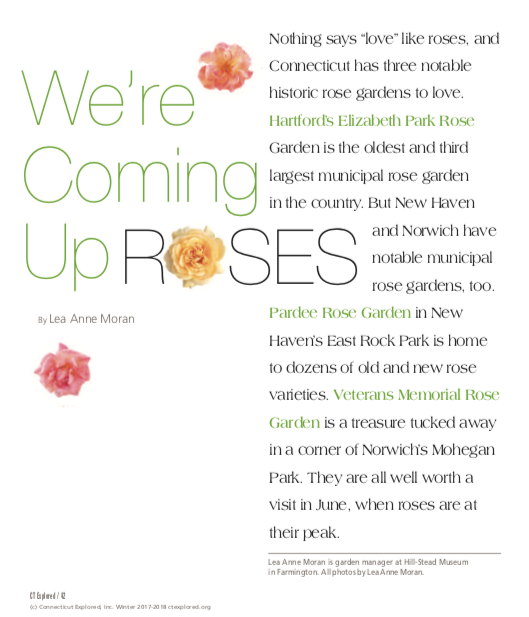 By Lea Anne Moran
By Lea Anne Moran
(c) Connecticut Explored Inc. Winter 2017-2018
Subscribe/Buy the Issue!
Veterans Memorial Rose Garden
Rockwell Street entrance to Mohegan Park, Norwich
Veterans Memorial Rose Garden (also known as Mohegan Memorial Rose Garden) is the newest and smallest of the trio. This little gem was dedicated in 1948 (and re-dedicated in 2008) to honor veterans of World War II and has been maintained by the City of Norwich ever since. It is set on a half acre at the southern tip of Mohegan Park, a wooded city park full of trails, a swimming pond, and picnic areas.
A rose garden is a fitting tribute to Norwich, known as “The Rose City.” It got that name after famed preacher Henry Ward Beecher visited about 1850 and admired the gardens there, calling it “The Rose of New England,” as the story was told in the Norwich Bulletin. A group of citizens led by Roy D. Judd in the 1940s determined that “The Rose City” should have a park befitting its name. They raised funds and hired Thomas H. Desmond, a landscape architect from Simsbury, to design the garden. Delayed by World War II, the rose garden was installed in 1947. Its first rose, “Lady Stanhope,” was planted April 16, 1947.
In 2008, the garden was enclosed by a tall fence to protect it from browsing deer, says Angelo Yeitz, the city’s superintendent of streets and parks. Today the beds are bursting with 120 rose varieties and 1,250 rose bushes.
Until 2013 the garden was a trial site for All American Rose Selections, a California company that provided roses in exchange for feedback about how they performed until the company closed in 2013. Memorial donations made in honor of a loved one are used to purchase new plants, as evidenced by plaques in the rose beds, an indication of the many visitors who have enjoyed the beauty of this rose garden.
Pardee Rose Garden
180 Park Road, Hamden
The Pardee Rose Garden is located on two acres of East Rock Park, a park that straddles Hamden and New Haven. It is operated by the City of New Haven. East Rock Park is listed on the National Register of Historic Places. The rose garden was created in 1922 with a gift from William S. Pardee (1860 –1918), a New Haven lawyer and businessman. He bequeathed funds to the city to create a rose garden “with flowers, (and) all that blossoms” to honor his mother, Nancy Maria English Pardee, as described in the Pardee papers held by the New Haven Museum. The original rose garden was symmetrical in design, with a long central row of arches dividing beds that contained 46 varieties of roses, including hybrid tea, polyantha, hybrid perpetual, climbers, and old garden roses.
According to Matthew Naab, the horticultural supervisor with the City of New Haven, the rose garden was re-designed in the 1970s, during a time of budget cutbacks. Superintendent of horticulture at the time, Landon Winchester, removed the central row of rose-covered arches and reduced the overall number of plants. It was in this redesign that the central wedding-cake shaped gazebo was added. The current garden holds 76 varieties, 1,500 bushes in all, and includes many new varieties along with some of the originals. The climbing roses “Cecile Brunner” and “American Pillar” are two that have been replanted in honor of the original plan.
Elizabeth Park Rose Garden
Prospect and Asylum streets, West Hartford
Elizabeth Park Rose Garden stands at the heart of the 101-acre Elizabeth Park, on the former estate of Charles Pond. Pond donated the land, which straddles Hartford and West Harford, to the city of Hartford, stipulating that the park be named in honor of his wife, Elizabeth. The park is listed on the National Register of Historic Places. The Elizabeth Park Conservancy website provides a wealth of information about the Pond family, the park, and its rose garden. The conservancy raises funds for the garden’s upkeep each year, and since 2016, has also maintained the gardens in the park.
In 1896 the City of Hartford hired Swiss-born landscape architect Theodore Wirth as superintendent of parks. By 1897 he had created a welcoming city park with Victorian flowerbeds, trees, shrubs, winding roads, and, in the style of Frederick Law Olmsted, a picturesque vista of the surrounding countryside.
In 1903 Wirth began designing the formal rose garden on 1.25 acres because he felt that “roses bring joy to the public,” the Elizabeth Park Conservancy website notes. The design fills a square that centers on a vine-covered gazebo sitting atop a four-foot rise of land. Eight rows of rose-covered arches radiate out from the center. The garden opened in 1904 with 116 beds, each filled with 16 to 60 plants of a single variety. In 1912 a semi-circular section was added at the south side to provide the first testing beds for the American Rose Society. In 1937 a matching semi-circular section was added to the north side, doubling the size of the rose garden to 2.5 acres. All American Rose Selections provided test roses until the company closed in 2013.
By 1911 people came from all around to visit the rose garden, and, according to the Elizabeth Park Conservancy, “a large manufacturer of postcards” sold more postcards of Elizabeth Park that year than of any other garden or park in the country.
The gazebo was rebuilt in 2005 with new cedar. It is fully covered once again with Virginia creeper (woodbine). Storm-damaged arches were replaced after the surprise snow storm in October 2012, and climbing roses are filling in to cover them.
Today the rose garden is one of the most visited and photographed gardens of Elizabeth Park, according to Andrea Masisak, the conservancy’s manager of gardens, grounds and volunteers. The rambler-covered arches bloom in mid-to-late June, lasting for just a few weeks. The beds of roses begin their colorful show in early to mid-June, and many continue blooming throughout the summer. The garden’s more than 800 varieties and 15,000 rose bushes include hybrid tea, hybrid perpetual, floribunda, shrub, and pillar roses. Old garden roses (those dating before 1867) can be found in the heritage rose garden recently restored by the Connecticut Valley Garden Club in a secluded section of the park beside the shade garden.
Lea Anne Moran is garden manager at Hill-Stead Museum in Farmington.
Explore!
Beatrix Farrand’s Connecticut Gardens, Summer 2006
LISTEN: Grating the Nutmeg Episode 115: America’s First Public Rose Garden – Elizabeth Park
Read more stories about Connecticut’s historic landscape and environment on our TOPICS page.

